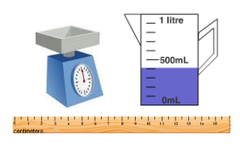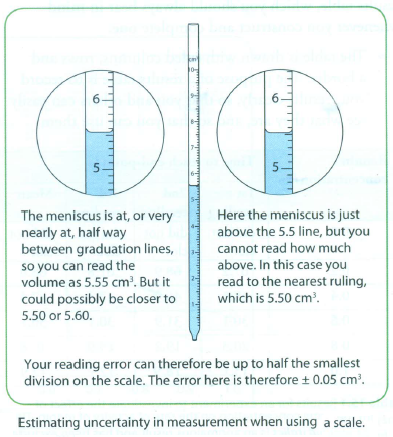Biology
 You will often be asked to take measurements or readings. In biology, these are most likely to be length, mass, time, temperature or volume.
You will often be asked to take measurements or readings. In biology, these are most likely to be length, mass, time, temperature or volume.
You could be taking readings from a linear scale (for example, reading temperature on a thermometer, reading volume on a pipette, or reading length on a potometer tube). You could be reading values on a digital display, for example reading mass on a top pan balance or time
on a digital timer.
There are some special terms that are used to describe measurements, and the amount of trust you can put into them. It's easiest if we think about them in terms of a particular experiment, so let's concentrate on investigation 1: Investigating the effect of temperature on the rate of breakdown of hydrogen peroxide by catalase. Look back at the the post #69 to remind yourself what is being measured.

Validity This is about whether what you are measuring is what you actually intend to measure. For example, in investigation 1, does measuring the volume of oxygen in the gas syringe each minute really tell you about the rate of reaction? It is a valid method in this instance, because the volume of oxygen given off per unit time is directly related to the rate at which the reaction is taking place.
Reliability This is how well you can trust your measurements. Reliable results are ones that are repeatable. This could be affected by various factors, such as whether you are able to take a reading at the precise time you intended to.
Accuracy An accurate reading is a true reading. For your readings of volume to be accurate, then the gas syringe must have been calibrated correctly, so that when it says the volume of gas is 8.8cm3, then there really is exactly 8.8 cm3 of gas in there.
Precision If you were able to put exactly 8.8 cm3 of gas into your gas syringe, and it read 8.8 cm3 every time, then your readings have a high degree of precision. If, however, the syringe didn't always read the same value (so there was variation in its readings, even though the actual volume of gas was exactly the same), then your measurements are less precise.
Resolution You probably already know this term, because we use it in microscopy to tell us the degree of detail that we can see. The smaller the detail, the higher the resolution. It means very much the same thing with a measuring instrument - the smaller the division on the scale of the measuring instrument, the higher its resolution. So, for example, a 10 cm3 gas syringe marked off every 0.5 cm3 has a higher resolution than a 20 cm3 gas syringe marked off every 1 cm3. If you get a choice, then go for the instrument with the highest resolution to make your measurements - so long as it can cover the range that you need.
Uncertainty in measurements- estimating errors
Whenever you take a reading or make a measurement, there will be some uncertainty that the value is absolutely correct. These uncertainties are experimental errors. Every experiment, no matter how well it has been designed, no matter how carefully it has been carried out and no matter how precise and accurate the measuring instruments, has this type of error.
You may be asked to estimate the size of the errors in your measurements. This is nothing to do with how well you have made the measurements - the examiners don't want to know about 'mistakes' that you might have made, such as misreading a scale or taking a reading at the wrong time. It is all about the inbullt limitations in your measuring device and its scale.
? In general, the size of the error is half the value of the smallest division on the scale. For example, if you have a thermometer that is marked off in values of 10C, then every reading that you take could be out by 0,50C. You can show this by writing: 21.50C ± 0.50C.

Tips
Every time you take a reading or make a measurement, get into the habit of working out and writing down the error (uncertainty) in each reading.
- #76 Summary Of Practical Skills
1 In an experiment investigating the effect of one variable on another, the independent variable is the one that you change and the dependent variable is the one that you measure. All other variables should be controlled (kept constant). 2 The...
- #71 Recording Measurements And Other Data
You will often need to construct a table in which to record your measurements, readings and other observations. It is always best to design and construct your results table before you begin your experiment, so that you can write your readings...
- #69 How To Get High Marks In Paper 3 - Variables
Many of the experiments that you will do during your AS course, and usually Question 1 in the examination paper, will investigate the effect of one factor on another. These factors are called variables. Types of variables The factor that you change...
- #20.factors Affecting The Rate Of Enzyme-catalysed Reactions
These factors are: - Temperature - pH - Enzyme concentration - Substrate concentration - Inhibitor concentration When an enzyme solution is added to a solution of its substrate, the molecules collide. With time, the quantity of substrate...
- #19. Following The Course Of An Enzyme-catalysed Reaction
Measurement of the rate of formation of the product or the rate of disappearance of the substrate. 1. Measurement of the rate of formation of O2 in the reaction: Mash up some biological material like potato tuber or celery stalks, mix them...
Biology
#70 Practical exam - Taking measurements

You could be taking readings from a linear scale (for example, reading temperature on a thermometer, reading volume on a pipette, or reading length on a potometer tube). You could be reading values on a digital display, for example reading mass on a top pan balance or time
on a digital timer.

Reliability This is how well you can trust your measurements. Reliable results are ones that are repeatable. This could be affected by various factors, such as whether you are able to take a reading at the precise time you intended to.
Accuracy An accurate reading is a true reading. For your readings of volume to be accurate, then the gas syringe must have been calibrated correctly, so that when it says the volume of gas is 8.8cm3, then there really is exactly 8.8 cm3 of gas in there.
Precision If you were able to put exactly 8.8 cm3 of gas into your gas syringe, and it read 8.8 cm3 every time, then your readings have a high degree of precision. If, however, the syringe didn't always read the same value (so there was variation in its readings, even though the actual volume of gas was exactly the same), then your measurements are less precise.
Resolution You probably already know this term, because we use it in microscopy to tell us the degree of detail that we can see. The smaller the detail, the higher the resolution. It means very much the same thing with a measuring instrument - the smaller the division on the scale of the measuring instrument, the higher its resolution. So, for example, a 10 cm3 gas syringe marked off every 0.5 cm3 has a higher resolution than a 20 cm3 gas syringe marked off every 1 cm3. If you get a choice, then go for the instrument with the highest resolution to make your measurements - so long as it can cover the range that you need.
Uncertainty in measurements- estimating errors
Whenever you take a reading or make a measurement, there will be some uncertainty that the value is absolutely correct. These uncertainties are experimental errors. Every experiment, no matter how well it has been designed, no matter how carefully it has been carried out and no matter how precise and accurate the measuring instruments, has this type of error.
You may be asked to estimate the size of the errors in your measurements. This is nothing to do with how well you have made the measurements - the examiners don't want to know about 'mistakes' that you might have made, such as misreading a scale or taking a reading at the wrong time. It is all about the inbullt limitations in your measuring device and its scale.
? In general, the size of the error is half the value of the smallest division on the scale. For example, if you have a thermometer that is marked off in values of 10C, then every reading that you take could be out by 0,50C. You can show this by writing: 21.50C ± 0.50C.

Every time you take a reading or make a measurement, get into the habit of working out and writing down the error (uncertainty) in each reading.
- #76 Summary Of Practical Skills
1 In an experiment investigating the effect of one variable on another, the independent variable is the one that you change and the dependent variable is the one that you measure. All other variables should be controlled (kept constant). 2 The...
- #71 Recording Measurements And Other Data
You will often need to construct a table in which to record your measurements, readings and other observations. It is always best to design and construct your results table before you begin your experiment, so that you can write your readings...
- #69 How To Get High Marks In Paper 3 - Variables
Many of the experiments that you will do during your AS course, and usually Question 1 in the examination paper, will investigate the effect of one factor on another. These factors are called variables. Types of variables The factor that you change...
- #20.factors Affecting The Rate Of Enzyme-catalysed Reactions
These factors are: - Temperature - pH - Enzyme concentration - Substrate concentration - Inhibitor concentration When an enzyme solution is added to a solution of its substrate, the molecules collide. With time, the quantity of substrate...
- #19. Following The Course Of An Enzyme-catalysed Reaction
Measurement of the rate of formation of the product or the rate of disappearance of the substrate. 1. Measurement of the rate of formation of O2 in the reaction: Mash up some biological material like potato tuber or celery stalks, mix them...
